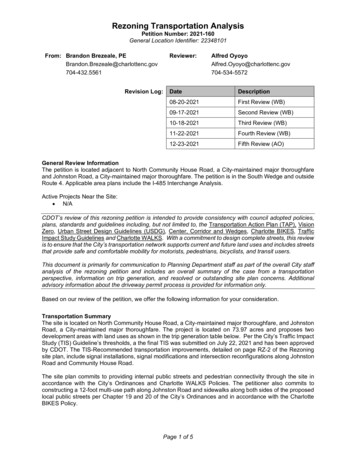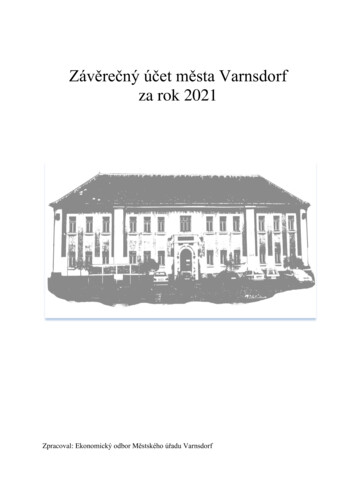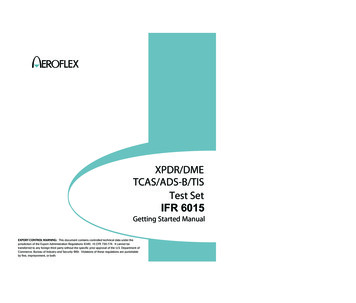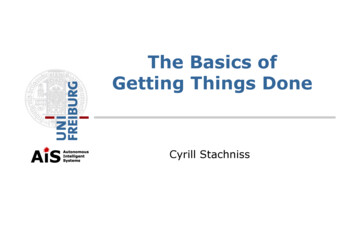
Transcription
’Tis done already, and the messenger gone.(W. Shakespeare, Antony and Cleopatra III.3)new messenger 2013 text.indd 714.11.2013 12:39:32
new messenger 2013 text.indd 814.11.2013 12:39:32
1 IntroductionThis book began as a doctoral project at Masaryk University1. The final dissertation thatconcluded my study of the phenomenon of the messenger in drama, its conventionaluses and final transformation into what I take the liberty to call “the new messenger”,then has been reworked into this publication.It presents the new messenger as a specific type of a character in the mainstreamdrama written in English of the second half of the twentieth century. In particular, itdraws its examples for case studies from the works of three playwrights: the BritishMichael Frayn and Tom Stoppard, and the American August Wilson. Analyses of theirplays made it possible for me to see the new type of a character in the first place andbrought me to the inquiry of the nature of the function that it has in these texts. Further, it was necessary to find out where the character comes from, what the history ofthe development of its usage is, and what currents in the history of drama there are thatenable its existence and fuel its function in the plays. The present book looks at the newmessenger from several perspectives and each of them find their expression in one orseveral chapters and call for a different type of argument to be sound and persuasive.When taken into account all at once, they create a multi-layered picture of the new messenger as a new convention, a character-type, a specific dramatic function, and a vehicleof artistic communication.Yet, the choice of authors and their works needs to be explained first. The choice hasto do with the development of the topic of this book and the preceding dissertationproject, which began as research in the field of implementing scientific issues into dramatic works. This is where the material for this topic included two English playwrights,Michael Frayn and Tom Stoppard. After looking into where their ability to explain science to theatre audience comes from, I realized that it is their journalist careers thatmade them skilful mediators of information. The focus shifted towards journalism andthe stage, an issue which is thematically broader than “mere” science.1) U nder the supervision of doc. Pavel Drábek, to whom I express my utmost gratitude for being myteacher and mentor. The thesis was defended at Masaryk University in September 2012.9new messenger 2013 text.indd 914.11.2013 12:39:32
1IntroductionAfter another extrapolation, I somehow identified the journalist as a special type ofthe messenger as it is known from the history of drama, that is to say a character whosepurpose is to inform and bring news. This is where August Wilson came in, as he hadlong been my favoured American dramatist. I admired his The Twentieth Century Cycle asa fictional chronicle, a dramatic version of a series of reports about African-Americaninhabitants of Pittsburgh by the decades of the 20th century. The idea was to comparethe journalistic approach to “actual” issues with “fictional” ones. The topic thus becameeven broader.But then, as it happens, the more I tried to identify the messenger as a unifying factor,the more the messenger alluded me, until I found that in fact there are no messengersin the plays! Yet, this moment of void proved to be a starting point for a fresh start. Themessenger was gone, but he or she still lingered in the plays, somehow. He or she didnot disappear completely. He or she was transformed and found new ways of enteringthe stage. Then the idea of the new messenger appeared as of a component of the plays,which has kept some of the properties of the conventional messenger but holds a wholeset of new ones. At this moment, the applicability of the concept of the new messengerbegan to press onto me and I tended to apply it on contemporary mainstream dramain general. But then I decided to remain with Frayn, Stoppard and Wilson as I believe,that it is for the best to show the reader the path I myself took. After all, these threedramatists were the three Fates present at the birth of the concept.The decision to remain with the three dramatists is based on two premises. The firstone is that it was the study of their works that lead to the notion of the new messengerin the first place, as I just sketched out. The second one is that they are mainstreamauthors and as such they work with dramatic tools and techniques which are functional, generally understandable, and acceptable by the audience. I believe that employingmainstream authors eventually shows that the idea of the new messenger is a viable andfunctional concept.This book starts with a traditional type of character in the dramatic convention – themessenger. It then identifies various transformations and variations of this characterin the history of drama and studies its more contemporary uses, while understandingthe the messenger as a certain type of character bearing specific functions. It claimsthat the messenger as a character remained a crucial character type especially in thehistorical/political mainstream play but that it also underwent several radical transformations.The book looks at the uses of the conventional messenger as well as its transformedappearances. It claims that in the recent decades and within the given context of theconcerned dramatic works, the traditional messenger has been substituted with a follower, which I call the new messenger. These contemporary messenger-figures on theone hand carry out the basic function of the conventional messenger, which is to reportabout facts and events from outside the frame of the stage action, and as such they fulfilthe original role of bringing new information to push the action forward. On the otherhand, the new messengers have acquired several new roles, namely that of widening the10new messenger 2013 text.indd 1014.11.2013 12:39:32
1Introductionfictional world of the play when they feed the other characters and audience with supplementary information, which create the context but do not need to be directly connected with the development of the plot. This use of the new messenger is identified inconnection with the concerned historical/political mainstream plays as assigning themthe function of political agents. Furthermore, the new messenger also continues in thedidactic tradition, when he presents information from scientific and other areas of contemporary knowledge, thus speaking directly about phenomena from the actual worldoccupied by the audience.The book builds up its observations on a fusion of several theoretical traditions, whenit focuses on the language and the modes of communication associated with the messenger (reportage), includes an approach capitalizing on the narrative grammar tradition(study of the structural role of the character as a type) and also attributes a great influence on the development of the messenger convention to Brecht’s Epic Theatre (shift inthe general understanding of how certain dramatic conventions work on the stage).The book presents a definition of the new messenger as a possibility of a main character with a name to become the new messenger. To do so, such character must possess specific qualities that grant him exclusive and legitimate access to information outside the scope of the logic of the dramatic action while remaining a useful and widelyused type of character. Focusing on the linguistic and narrative levels, the book givesa number of examples of characters that legitimately leave their roles for a short whileto switch to the narrative mode in order to deliver a reportage from a sphere of their expertise, such as hands-on experiences from the past in the case of eye-witnesses, politicaland historical commentaries in the case of politicians and journalists, as well as lessonsin various areas of science and history of the Western thought in the case of scientistsand philosophers.To show the conventional messenger and the variability of its traditional uses, Oedipusthe King, Antony and Cleopatra, and The Glass Menagerie are analysed in a separate chapter. As far as the various types of the new messenger are concerned, this book focuses onthe plays by Frayn, Stoppard and Wilson, capitalising on the success of their plays whichsignals an understandability of the application of a transformed type of conventionalcharacter, the new messenger. Case studies of, for example, Frayn’s Democracy, Stoppard’s Arcadia, Wilson’s The Piano Lesson show how the new messenger retains the mainfunction of the traditional messenger, which is to push the action forward. Analyses of,for example, Stoppard’s Night and Day and Rock’n’Roll, Wilson’s Fences, Two Trains Running and Jitney and Frayn’s Afterlife identify a role of the new messenger which alreadyseparates it from its conventional older counterpart, when the new messenger interpretsfacts and events from the fictional (and sometimes actual, too) world to the others, thusbecoming a political agent. Finally, case studies of, for example, Stoppard’s Hapgood andThe Coast of Utopia trilogy, as well as Frayn’s Copenhagen, show the new messengers inthese plays in the light of the didactic tradition of the stage when they operate as teaching agents.Although the need for a messenger and its traditional function survives, the application has undergone a radical structural change which lead to the abandonment of the11new messenger 2013 text.indd 1114.11.2013 12:39:32
1Introductionconventional messenger and introduction of the more dynamic figure, the new messenger.1.1Structure of the BookIt is perhaps necessary to admit here, and thereby prepare the reader for it, that theargument of the present book does not unfold in a clear-cut, straightforward fashion.There are several types of argument structures employed. Chapter 3 “The Messenger asa Convention” is a historical overview; chapters 4 “The Poetic Tradition, 5 “The PragueSchool Theory of Theatre and Drama” and 6 “Morphology and the Theory of Actants”are theoretical; chapter 7 “Brecht’s Heritage” studies the role that Brecht’s Epic Theatre’s radical transformations played in understanding the old dramatic and theatricalconventions from a historical perspective; chapters 8 “Reportage” and 9 “IntroducingNew Messengers” are deductive, building up on the principle of what the new messengeris; and finally, chapters 10 “New Messengers on the Stage”, 11 “Pushing the Action Forward, 12 “Interpreting for others” and 13 “Informing (about) the Actual World” consistof case studies following the analytical, inductive tradition. The reason for this methodological eclecticism is that there are a number of ways that lead me to the subject matter,which is the character of the new messenger.In greater detail, the chapters of the book are arranged in the following order. This“Introduction” is followed by chapter 2 “Why Mainstream”. As I have already indicated,the whole idea of the new messenger is based on the study of the works by three mainstream authors. For this reason I find it important to explain what I mean by mainstreamand why I consider it useful to study authors that belong there. The chapter thus dealswith the relevance of dealing with mainstream for a theoretical study of drama. It alsosupports the claim that the new messenger has become a widely used dramatic convention.Chapter 3 “The Old Messenger” introduces the classical convention used throughoutthe history of drama. It is a historical overview of what I consider the most influentialuses of the messenger in the history of drama and as such it presents analyses of Oedipus the King by Sophocles, Antony and Cleopatra by William Shakespeare, and The GlassMenagerie by Tennessee Williams. The chapter explains how the convention of the messenger works and shows its three various uses. It is in breaking away from the conventional usages of the messenger that the new messenger could begin to function as a newconvention.Chapters 4 to 6 could be included under a shared title, as they present the theoreticalbackground of this whole book. They introduce theories that have shaped the theoreticalunderstanding of the new messenger as it is handled here. Chapter 4 “The Poetic Tradition” capitalises on Aristotle as a part of the Western approach to the study of drama,which views a piece of art as structure that can then be analysed. This view contributedto a concern of the new messenger as a component of the dramatic structure with itsspecific place and purpose.12new messenger 2013 text.indd 1214.11.2013 12:39:33
1.1 Structure of the BookChapter 5 “The Prague School Theory of Theatre and Drama” continues with selected issues from the works of the Prague School. It identifies the School as an important source for the semiotic approach to drama and theatre, which also shapes theunderstanding of how the element of the new messenger operates within a play whenviewed as a system of signs. A greater attention is paid to the issue of the functions oflanguage, mainly on the coexistence and interaction between the aesthetic function oflanguage and the referential function of language. This approach of the Prague Schoolmakes a theoretical background to understanding how characters switch between various modes of delivery (from dialogue to narrative, for example), which this book identifies as one of the principles of the new messenger’s materialization on the stage.Chapter 6 “Morphology and the Theory of Actants” then deals with another theoretical concept, which also comes from the structural poetic tradition. This concept is narrative grammar, in particular as devised by Vladimir Propp and then applied to drama byA. J. Greimas. Both theoreticians came up with a system of character-functions, that is tosay with an applicable set of roles within the development of a narrative in general. Particular characters are then only viewed as carriers of these functions. However abstractand limiting this approach may seem, it is convenient to view the new messenger fromthis perspective when its abstract and general qualities need to be deduced. So, thesethree perspectives form the main theoretical background of the concept of the new messenger, based on which the deductive argument is based.Chapter 7 deals with Bertolt Brecht and it proved to be necessary to include it fortwo reasons. One, Brecht tends to come up when the issue of “political” drama arises,as is the case of the three authors in focus in the present book. More about that in thechapter itself. Two, the chapter claims that it was Brecht’s influence that had a directinfluence on the emergence of the new messenger. The reason to hold this stance is thatBrecht’s radical innovations redefined theatrical illusion and exposed some theatricalconventions. As a result, these conventions stopped fulfilling their role, that is to say thatthe audience not only see through them, they do not accept them. The convention ofthe messenger is among them, which has to do with Brecht’s use of reportage. In thissense, drama needed to substitute for the messenger and Brecht stood at the emergenceof the new messenger.Chapter 8, “Reportage” capitalises on the theoretical chapter and identifies reportageas a narrative technique which is the main identifying element of the messenger as wellas its new follower. It stands in contrast to Brecht’s use of reportage and shows how itworks when employed to inform about facts and/or events from outside the frame ofthe on-stage action, which is, in fact the main role of the (new) messenger. This chapteralso theorizes the three case studies which make the introduction of the present work,thus creating ground for introducing the new messenger.This happens in Chapter 9. This chapter is central to the present book, as it on theone hand follows from all the preceding chapters with their historical and theoreticalperspectives, and on the other hand it can be viewed as a generalization based on theanalyses performed in chapters 11 to 13. As such, the chapter presents to the reader thekey elements of the issue of the new messenger when viewed as a character-type with13new messenger 2013 text.indd 1314.11.2013 12:39:33
1Introductiona specific role within the structure of the plot development, but it also introduces themechanism that allow characters to step out of their roles and assume the role of themessenger for the given time. However, this chapter would seem unconvincing withoutthe preceding theory and the claims it make call for studies of applications which areabout to be presented in the following chapters.Chapter 9 is an introduction to the analytical chapters 10 to 13 as it explains the structure of the analyses in general terms. It is therefore the analytical chapters that thenform a substantial part of the book. They contains of a number of case studies of playsby Frayn, Stoppard, and Wilson. These case studies are performed from the perspectiveof identifying and explaining the role of the new messenger, focusing on those aspectsof the plays that are relevant to the issue. Chapters 11 to 13 each focus on a differentrole that the new messenger has. First of them deals with the new messenger as an agentthat pushes the action forward, which is a function that it shares with the traditional messenger. However, specific new applications are introduced in the two following chapters.Chapter 12 is a presentation of the new messenger as an interpreter of facts and events,which make the new messenger a political agent of the contemporary mainstream theatre. In this way, the new messenger is a propeller of social debate and communication,which follows from the tradition of drama and theatre in particular as the focus pointof a public forum. Chapter 13 presents the teaching role of the new messenger whenextrafictional information about the actual historical is explicated to the audience. Here,the new messenger follows in another tradition of drama, which is its educative role.A summary of the given case studies with general conclusions follows the case-studieschapters. “Epilogue” is a short farewell to the topic of the new messenger.14new messenger 2013 text.indd 1414.11.2013 12:39:33
Michael Frayn and Tom Stoppard, and the American August Wilson. Analyses of their plays made it possible for me to see the new type of a character in the first place and brought me to the inquiry of the nature of the function that it has in these texts. Fur-ther, it was necessary to find out where the character comes from, what the history of










